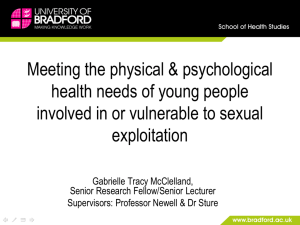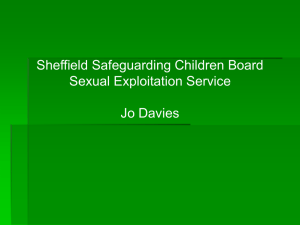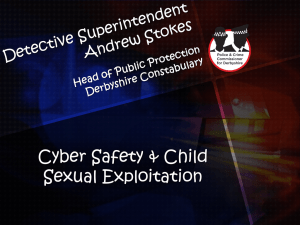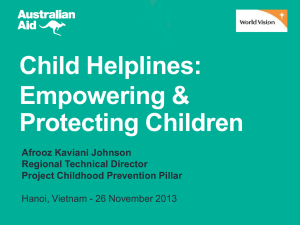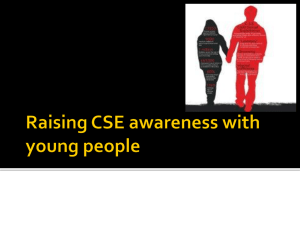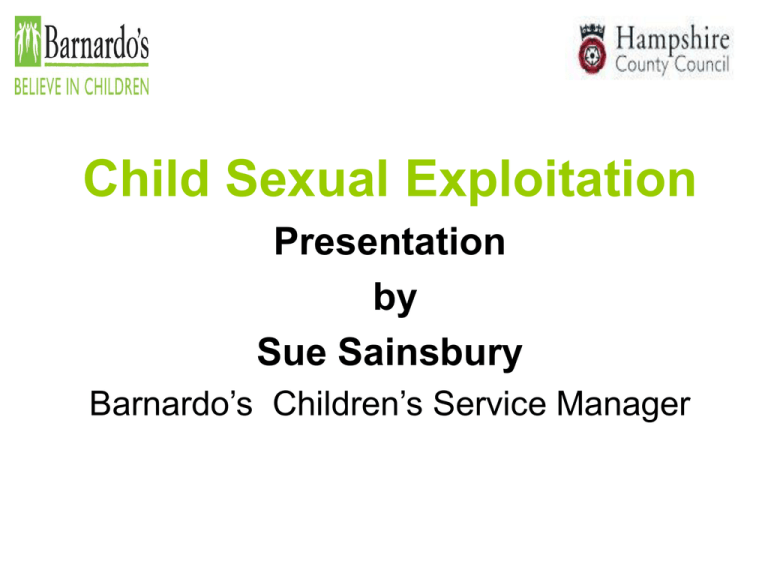
Child Sexual Exploitation
Presentation
by
Sue Sainsbury
Barnardo’s Children’s Service Manager
Raising Awareness
Child Sexual Exploitation is not new!
Definition of child sexual exploitation
Models of child sexual exploitation
Grooming Process
The role of the internet in sexual exploitation
The sexual exploitation of boys
Challenges
The need to protect
How we work/what we do
Multi-agency response
Perpetrators of child sexual exploitation
Further support and advice
CSE in the news
CSE – A new phenomenon?
Late 19th century – Campaigners depicted child prostitutes as
“betrayed innocents” which led to increased age of consent from 13
to 16 – Criminal Law Amendment Act 1922
Interwar period – Judges commented on “wickedness of girls under
16 seducing men twice as old as themselves”
1989-95 – 1,700 convictions of under 18s for offences relating to
prostitution plus 2,300 cautions (40% increase in under 16s) - Four
12yr old girls convicted and two 14yr old boys. Youngest conviction
was a 10yr old.
2004 – there were three prosecutions
2007 – Judges describe 13yr old girls as “sexually promiscuous and
active” and “prostitute and heroin addict”
CSE – A new phenomenon?
2012 - Nine men were found guilty of offences relating to
a localised grooming network based in Rochdale.
2013 - Seven men from Oxford were convicted of
offences relating to child sexual exploitation at the Old
Bailey in London. The offences which had taken place
from 2004 to 2011, included rape, arranging child
prosecution Sexual activity with a child and trafficking a
child within the UK for sexual exploitation.
Definition of child sexual
exploitation
Sexual exploitation of children and young people under 18 involves exploitative
situations, contexts and relationships where children (or a third person or persons)
receive ‘something’ (for example, food, accommodation, drugs, alcohol,
cigarettes,
affection, gifts, money) as a result of performing sexual activities and/or
another
performing sexual activities on them.
Child sexual exploitation can occur through the use of technology without the child’s
immediate recognition, for example persuasion to post sexual images on the
internet/mobile phone with no immediate payment or gain.
In all cases those exploiting the child/young person have power over them by virtue of
their age, gender, intellect, physical strength and/or economic or other
resources. Violence, coercion and intimidation are common, involvement in
exploitative relationships being characterised in the main by the child or
young person’s limited availability of choice resulting from their social/economic
and/or emotional vulnerability.
(Definition by NWG and cited in DCSF guidance)
Models of CSE
Barnardo’s has found that child sexual exploitation tends
to be
a hidden activity and much more likely to take place in
private residences than visibly, on the streets. Barnardo’s
has identified three different models of activity; they are
not exhaustive, but show a spectrum of exploitation.
Exploitation through befriending and inappropriate
relationships
Peer Exploitation/Gangs & Groups
Organised/networked sexual exploitation trafficking
Exploitation through befriending
and inappropriate relationships.
Inappropriate Relationships/Boyfriend model of
exploitation where one perpetrator who has inappropriate
power or control over a young person ( physical, emotional or
financial).
One indicator may be a significant age gap. The young person
may believe they are in a loving relationship.
The perpetrator befriends and grooms a young person into a
‘relationship’ and then coerces or forces them to have sex with
friends or associates.
Grooming
The word grooming is used to describe the
process that abusive adults use to trick a child or
young person into believing that they are
trustworthy so that they can eventually sexually
exploit the young person
Exercise
Spend 10 minutes discussing with the person
next to you about the early stages of a
relationship you have been in and the type of
things you or your partner did for each other.
Peer Exploitation/Gangs & Groups
Peer Exploitation – young people are forced or coerced into sexual
activity by peers and associates. The exploitation appears to be
taking place within age appropriate associations or relationships.
Research within Barnardo's services identified a significant issue
with groups of young people hanging around in parks drinking
alcohol given by older people or peers and having sex.
Gang – mainly comprising men and boys aged 13 – 25 years old,
who take part in many forms of criminal activity, such as knife crime
or robbery, who can engage in violence against other gang ,and who
have identifiable markers such as territory, a name, sometimes
clothing etc.
Group - involves people who come together in person or online for
the purpose of setting up, co-ordinating and/or taking part in the
sexual exploitation of children in either an organised or opportunistic
way.
Organised/Networked Sexual
Exploitation/Trafficking.
Young people (often connected) are passed through networks,
possibly over geographical distances, between towns and cities
where they may be forced/coerced into sexual activity with multiple
men. Often this occurs at ‘sex parties’, and young people who are
involved may be used as agents to recruit others into the network.
This internal trafficking of British children within the country often
involves a number of perpetrators and is more sophisticated in the
way that it is organised. Some of this activity is described as
serious organised crime and can involve the organised ‘buying and
selling’ of young people by perpetrators.
The role of the internet in
sexual exploitation
The internet as an instrument
of abuse
(Selling) children online for abuse on-line
Grooming children on-line for
sexual abuse offline
Making abusive images of children
Children viewing abusive
images of children
Viewing abusive images of
children
Children viewing adult
pornographic images
Access to internet
and chat lines
Selling children online for abuse offline
Contact via mobile phones
General criminality
‘Sexting’ in your local area
SEXTING IS DEFINED AS THE “EXCHANGE OF SEXUAL MESSAGES OR
IMAGES” AND “CREATING, SHARING AND FORWARDING SEXUALLY
SUGGESTIVE NUDE OR NEARLY NUDE IMAGES” THROUGH MOBILE
PHONES AND THE INTERNET.
• Alarming rise in 'sexting' craze
across Hampshire schools
• WHEN a class of 13-year-olds were
asked to raise their hands if they had
sent an explicit naked picture of
themselves or knew someone who had,
the response was shocking. Every child
in the Southampton classroom put their
hands up for the random survey. (Daily
echo April 2013)
E-Safety – we need to understand…
• the reasons why young people are taking and
forwarding these images
• the issue of trust in relationships
• how photos can end up out of the hands of the intended
recipient and be circulated much more widely
• the speed at which images can be spread on the
internet
• the online and offline bullying which may occur as a
result
• the idea of digital footprint and online reputation
• the legal implications of self-generated indecent images
• the process of removing content online, and where to
seek further help and advice
The role of technology in CSE
• Services reported that the scale of online and mobile
abuse has markedly increased even since 2010. Almost
all services reported it as an increasing priority, and some
have identified that the majority of their service users
were initially groomed via social networking sites and
mobile technology.
• ‘The use of technology is such a big issue. I hear of
young people who posting appropriate pictures of
themselves on the internet through the encouragement of
others. I hear about grooming of young people by older
adults over the internet which progresses onto mobiles.
Sexual bullying and threats over the internet and mobiles,
we hear about this all the time.’ [Service manager]
Sexual exploitation of boys
common scenarios
Older men offering paid work/ “odd jobs”
Older man often known to the young man
Develop a trusting friendship
Young person feels like they owe something back.
Young man exploring their sexuality in risky ways.
Seeking sexual experiences
Targeted/ arranging to meet in public sex environments
Young men searching for men on the internet
Involving young men in sexual exploitation through parties.
Huge amounts of drugs and alcohol given.
Older boys used to recruit younger
Organised
Young men given money and mobile phones.
Sexual exploitation of boys
common factors
Isolation
Lack of self confidence
Drug and alcohol abuse
Family instability/homelessness/looked after
Organised groups trafficking young people
between cities
Limited awareness of risk
Sexual exploitation of boys
differences
More hidden
More isolated from peer group
Perceived to be at less risk
Young men are less likely to have an “emotional
attachment” to one individual who is exploiting
them.
Risk can be created in part by them exploring their
sexuality by seeking unsafe sexual encounters.
Use of internet a significant factor
Greater reluctance to seek help from services
Exercise - why don’t young
people tell?
Why young people don’t
tell?
Children may not see it as abuse or dangerous
Too trivial
Shame / embarrassment
Culture of fear/silence
Blame self
Rewards often appear to outweigh the risks
Fear situation would get worse
Children may be involved in other criminal or antisocial activity
Exercise –What draws
young people back to their
abusers
come up with some ways to
overcome these barriers.
What might draw children
back to their abusers
Fear
Loss of trust in ALL adults
Low self-esteem
Worry about …
Feel like criminals
Emotional / psychological
distress
Mental health issues –
could include:
• Post Traumatic Stress
Disorder
Dependant relationship with
exploiters
Flashbacks, nightmares,
anxiety attacks, irritability and
other symptoms of stress.
A loss of ability to concentrate
Present as anti-social,
aggressive and angry, and/or
fearful and nervous, finding it
difficult to relate to others
Grief and loss
Challenges
Sexually exploited young people are often a hard to reach
group because…
The grooming process creates what we call a “willing
victim” meaning that the young people often do not
realise or accept that they are being sexually exploited. It
takes time for young people to accept their own abuse.
Young people are likely to get very defensive or refuse to
engage with their worker if they see them as being critical
of the young person’s “boyfriend”,
If the abusing adult involved with the young person sees
Barnardo’s as a threat, they can try and stop the young
person from engaging with the service.
Challenges
These young people can lead chaotic lifestyles
which can be due to their substance use and life
circumstances.
Many of them are frequently missing making them
difficult to get hold of. Appointments are often
missed, or cancelled.
Challenges
These young people often have little positive
experience of adult support and many are
disengaged from all services. They are mistrustful
of adults or professionals. As part of the voluntary
sector we find it easier to engage with young
people than statutory services as young people
have the choice as to whether or not they wish to
engage with the service.
If they don’t have to, they probably will want to!
Perceptions-why does it matter?
Recent serious case reviews state that young people need to be listened
to and that adults need to take their disclosures seriously.
The Rochdale SCR(2012) review stated that services put into place to safeguard
children and young people are still not acting on disclosures that children make
and ‘had the needs of these young people been better identified and addressed
at an early stage, the risks of later abuse might have been reduced’.
Many of the disclosures made to adults saw the young people being blamed for
the sexual exploitation experienced. They were dealt with as ‘rebellious
adolescents’ and two young people ‘received criminal convictions for behaviour
that should have been dealt with in terms of their status as victims of abuse
rather than as offenders’. The perception of young people is the assumption that
they are ‘consenting or ‘asking for it’.
This is far from a reality- Perceptions Need to Change.
It’s not a choice…
Because grooming process often creates what is known as a
“willing victim” it is vital to remember that…
Children and young people cannot consent to their own
abuse.
Consent does not make an unlawful act lawful.
Sexual exploitation is an area which always has significant child
protection concerns as children involved in prostitution and
sexual exploitation should be considered as victims of abuse.
Child Protection
Sexual exploitation is an area which always has significant
child protection concerns as children involved in prostitution
and sexual exploitation should be considered as victims of
abuse.
A child protection concern as defined by section 47 of the
Children Act 1989 is where a child is considered to be at risk
of “significant harm”.
If we look at the 4 categories of abuse as defined by the
Children Act 1989 we have examples of concerns in cases of
sexual exploitation which would fall into all 4 categories.
What does this really mean?
For our young people it means:
Physical assault
Rape
Emotional abuse
Isolation
Humiliation/ embarrassment
Fear
Confusion
“I love him because he
looked after me, bought me
nice things. Then he asked
me to have sex with this
man because he owed him
money. He said he would kill
him if he didn’t pay up, so I
did it. Now he threatens to
kill me and beats me up if I
don’t sleep with who he
says.”
16-year-old girl.
Professional Duties.
Any person working with under 18’s have a responsibility to
safeguard and promote the welfare of children.
Any person working with under 18’s have a duty to pass on
child protection concerns. This also includes concerns about
young people with whom you may not be working.
It is YOUR responsibility to make the assessment as to
whether you suspect a young person is at risk- not the
young person’s.
Child Abduction Legislation.
Sub-Section 2(1) of the Child Abduction Act 1984 provides an
offence in relation to the taking or detaining of a child where
the offender is not connected with that child. It states: "any
person other than the parent, lawful carer, etc, commits an
offence if without lawful authority or reasonable excuse, he
takes or detains a child under the age of 16 years:
(A) so as to remove him from lawful control of the person
having lawful control of the child or,
(B) so as to keep him out of the lawful control of any person
entitled to lawful control of the child."
What can we do.
Barnardo’s works from the model of practice “The 4 A’s”;
Access. Either by referral from another agency or self
referral. Flexible, responsive and on the young person’s own
terms.
Attention. We “hook” a young person out of an unsafe
relationship into positive ones with persistence and by
focussing on issues that matter to the young person.
Assertive Outreach. Consistent and persistent attention
from a named worker including texts, calling and cards and
meeting the young person on their own ground.
Advocacy. Establishing and maintaining effective
Our Aim
Although our ultimate aim is to support these young
people to be removed from sexual exploitation this does
not happen quickly.
By focussing on their vulnerability factors and risk
indicators we can reduce how much at risk the young
person is.
Complex Needs
The young people we are working with generally
have a range of complex needs and difficulties
including…
Substance misuse, going missing, mental health
problems, self
harm/ suicide attempts, housing issues, NEET,
family breakdown, domestic violence, eating
disorders, historic and current abuse, sexual
health problems and low self esteem.
Multi Agency Working!
• In order to protect children ALL agencies need to
adopt a multi agency approach. This is the best
way to manage risk.
• You don’t know everything! All agencies hold just
one small piece of the jigsaw. It’s only by putting
these pieces together that we see the full picture.
• Remember, protecting children is the
responsibility of adults, not of the children
themselves. Sometimes we have to protect
children against their own will.
• A multi agency approach is needed to help
identify dangerous people which helps with our
assessment of risk and protection of young
people
Perpetrators of CSE
Characteristics of a ‘groomer’
Friendly
Good communicator
Good listener
Acute observer – able to identify weak spots
or ‘hooks’ very quickly
Skilful with young people
Manipulative
Clever
Quote from a groomer
“These were throw away girls,
no more ‘ worthy than a
lollipop thrown down on the
ground”
Adil Rashid, 18 - admitted to having sex with a 13 year old girl
groomed on the internet.
Key Points
Prevention and early intervention are vital when indications
of risk are first identified-awareness of risk is key to prevention.
A child cannot consent to his/her own abuse and sexually
exploited children are in need of protection.
Using the legislation in a proactive way-but if we cannot
prosecute we can at least disrupt
Confront and challenge attitudes and values that confirm
some young people are worthless
It is critical that accessible and acceptable services work
alongside these children in some very risky and distressing
situations
Government Action Plan (2011)
Local authorities must map the needs of their own area
Monitor ongoing prevalence and responses
Develop an effective local strategy ensuring there is a co-ordinated
multi-agency response
Increase understanding of child sexual exploitation, in the
professional and wider community
Safeguard and promote the welfare of groups of children who are
potentially more vulnerable than others and are at increased risk of
child sexual exploitation, by: establishing effective communication
channels between the LSCB and partner agencies, including specialist
services which have an important role to play; attending voluntary and
community sector conferences to increase personal knowledge; providing
briefing to social care teams; and arranging multi agency training
days/courses
The action plan follows the publication of the Puppet on a String
report by Barnardo's
Further support and advice
Assumptions
Changing Perspectives
Think about the terms…
• Teenage Prostitute
• Rent Boy
If young people hear these terms what
other terms would come to their mind;
what images and ideas of their
lifestyle etc ?
Young People’s Responses
slut
CRACK WHORE slag
dirty ho
SLAPPER tart
DISGUSTING
BUMMER BOY
filthy
nympho
DRUGGIE sket
wants it BIKE
street corner SMACK HEAD streetwise
man whore
GAYLORD
STI’s
waster
high class hooker
loads of money CHEAP
gross
Professionals Responses
Popular assumptions
She’s Promiscuous
She is prostituting
herself
He is making a
choice She’s always doing this She is putting
herself at risk He’s sexualised.
He is
over the age of consent/ it’s legal
There’s nothing we can do
It’s their boyfriend/ partner
Attention seeking
Manipulative
They want the money/ drugs He is streetwise
He is giving consent
It’s legal
Change Our Perspective
Vulnerable ABUSED low self esteem
manipulated
neglected
HURTING
Coerced
INNOCENT trusting
Inexperienced young testing boundaries
LOOKING FOR LOVE scared AT
RISK
acting out past trauma GROOMED
Learned behaviours ANGRY
confused
Needing attention wanting to feel grown up
Hampshire Children’s Services
Department are developing a Multi
Agency Safeguarding Hub to run
alongside existing services provided by
Hants Direct and the Children’s
Reception Team. This is a new way of
responding to referrals
Referral Pathway to Children’s Social Care
Public
Hantsdirect
Professionals
Line
Children’s Reception Team
Embedded Social Work Team
Signposted
Social Care
HCC is well positioned to develop a
MASH following the successful
implementation of a Multi Agency CYP
triage group alongside the Children’s
Reception Team. The MASH model is
widely accepted as best practice and is
a logical step for Hampshire
Triage of Police Reports
Police CYP Referrals
TRIAGE
Police / Health / Social Care
Health
NFA
Police
Social Care
• A Multi Agency Safeguarding Hub or MASH was first
developed in Devon in 2010 following a Police and
Children’s Services initiative for developing services
which provided true multiagency assessment and
triaging of safeguarding concerns.
• The purpose was a dedicated multiagency team to
protect the most vulnerable children and adults from
harm, neglect and abuse.
• The Devon model trialled the use of police
intelligence to make risk based assessments, and
was a recommended example of good joint working
in the final Munroe report 2011/12 which urged
Children’s Social Care to consider new single access
methods of ‘gate keeping’.
Partners involved in MASH
•
•
•
•
Children’s Services inclusive of education and YOT.
Police
Adult Social care
Health.
Virtual partners
•
•
•
•
•
Probation
Housing
District Councils
Hampshire Fire and Rescue Service
Hampshire Ambulance Service
MASH
CYP triage
CA12
Children
Social Care
&
Education
Health
Adult
Services
Police
Virtual
Hampshire
Probation
HampshireF
ire /
Rescue
Hampshire
Ambulance
service
Housing
Borough
and District
Councils
Community
Safety
Troubled
Families
Desired Outcomes of MASH
• A faster, more co-ordinated and consistent
response to safeguarding concerns about vulnerable
children and adults.
• An improved ‘journey’ for the child or adult with a
greater emphasis on early intervention and better
informed services provided at the right time.
• A more straightforward and responsive process for
the professional or citizen raising a concern, with
clear guidance and support.
• Closer partnership working, clear accountability and
improved multi-agency communications.
• A reduction in the number of inappropriate referrals
and re-referrals.
Benefits of MASH
• The MASH gives quicker response times with
a better coordinated approach to resources
meaning each agency works more effectively
and efficiently in their own field of expertise.
• The proven reduction in inappropriate
referrals and re-referrals means that time and
resources are targeted most effectively and
savings are made.
• The proven reduction in inappropriate
referrals and re-referrals means that time and
resources are targeted most effectively and
savings are made.
• Staff and agencies have an increased
understanding and appreciation of each
others roles and responsibilities leading to
increased skills, better multi agency working
and more effective judgement.
• Development of flexible working patterns and
providing enhanced customer service.
Process for Referrals from
January 2014
• Contact made to CRT
• CRT will either signpost to Early Help or transfer to
MASH
• MASH will research and gather information from colocated and virtual partners
• MASH will decide whether Early Help or Statutory
Assessment by Children’s Services is required
• CP Strategy discussions will be face to face and take
place in MASH
• CRT and MASH will use the SERAF tool.
Case Study
• Michelle is14yrs 6mths old. Over the last few months
she has been truanting from school and coming
home late. There have been some arguments
between Michelle and her parents. Michelle has
stopped attending afterschool clubs and no longer
confides in her teachers. She has accessed the
sexual health clinic for the morning after pill on one
occasion and states her sexual activity was
consensual. Recently she has been sending clothed
but provocative pictures via her mobile to unknown
males.
Feedback
• What are the risks for Michelle ?
• Would completion of a SERAF assist in
structuring your thinking around CSE risks ?
Hampshire CSE Working Group
•
•
•
•
•
•
Multi-agency partners
Terms of reference
Strategic - MET/Hotspots/Analysis
CSE Leads in Children’s Services
Operational
Early Help – threshold matrix.
Questions?

